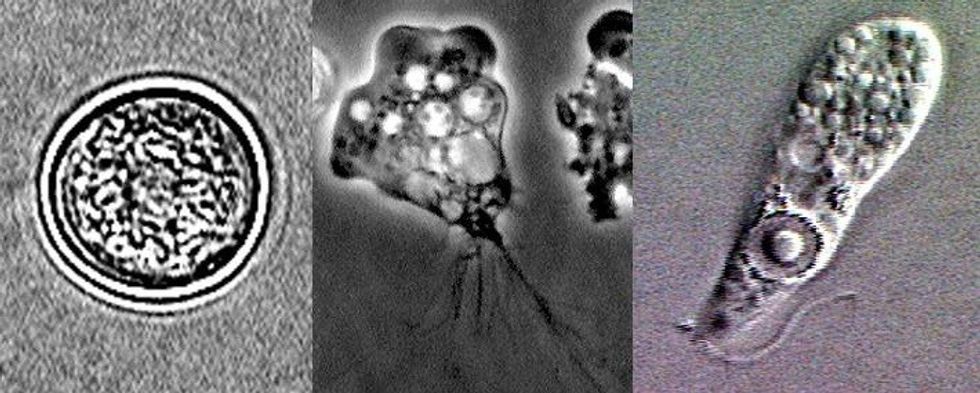Holidaymakers given urgent warning as brain-eating bug kills second victim

Histopathology of amebic meningoencephalitis due to Naegleria fowleri.
|Wikimedia Commons/CDC
Warm freshwater microorganism that enters through the nose is nearly always fatal
Don't Miss
Most Read
Freshwater swimmers have been advised to think twice before diving into warmer waters, after a second person passed away in the US this month from a brain-eating bug.
The single-celled living organism officially known as Naegleria fowleri, causes extensive brain damage when the amoeba enters the body through the nose.
An unnamed victim has died in Georgia, US, after swimming in freshwater, health officials confirmed on Friday.
Naegleria fowleri "destroys brain tissue, causing brain swelling and usually death," the Georgia Department of Public Health said.

Naegleria fowleri lifecycle stages
|Wikimedia Commons/CDC
Earlier this month, a two-year-old child tragically died after visiting the hot pools of Ash Springs in Nevada, near Las Vegas.
Just four out of 157 people recorded to have been infected with the amoeba in the US have survived since 1962, according to the Centre for Disease Control (CDC).
Males under the age of 14 are said to be most susceptible, though the reasoning for this remains unclear.
Naegleria fowleri is contracted in warm, freshwater, where the bug enters the body through the nose, then destroying the brain tissue and causes a devastating infection called primary amebic meningoencephalitis (PAM).
Number of Case Reports of Primary Amebic Meningoencephalitis Caused by Naegleria fowleri (N=157) by State of Exposure— United States, 1962–2022
|Wikimedia Commons/CDC
Only visible under a microscope, the single-celled living organism is heat-loving (thermophilic) and tends to be found in warm fresh water such as lakes, rivers and hot springs.
In very rare instances, people have gotten Naegleria fowleri infections from recreational water that didn’t have enough chlorine in it, such as pools and water parks.
Naegleria fowleri cannot be spread from one person to another.
Symptoms occur in two stages, with the first starting 1 to 12 days after infection, and including severe frontal headache, fever, nausea and vomiting.
HEALTH LATEST:

Hot springs at Yellowstone National Park
|Unsplash
Later, symptoms of stage two include a stiff neck, confusion, seizures, altered mental status, hallucinations and a possible coma.
After symptoms start, the disease usually causes death within about 5 days, but death can happen within 1 to 18 days, according to the CDC.
In order to avoid infection, the CDC suggests people hold their nose shut with nose clips or keep their head above the water when taking part in water-related activities in bodies of warm freshwater.
The CDC also goes further in recommending the total avoidance of water-related activities in warm freshwater during periods of high water temperature.
Furthermore, the CDC advises people to avoid digging in or stirring up sediment while in shallow, warm freshwater areas for the bug is known to reside in the soil.
Unfortunately, there are no rapid, standardised testing methods to detect and measure the amount of Naegleria fowleri in water.










